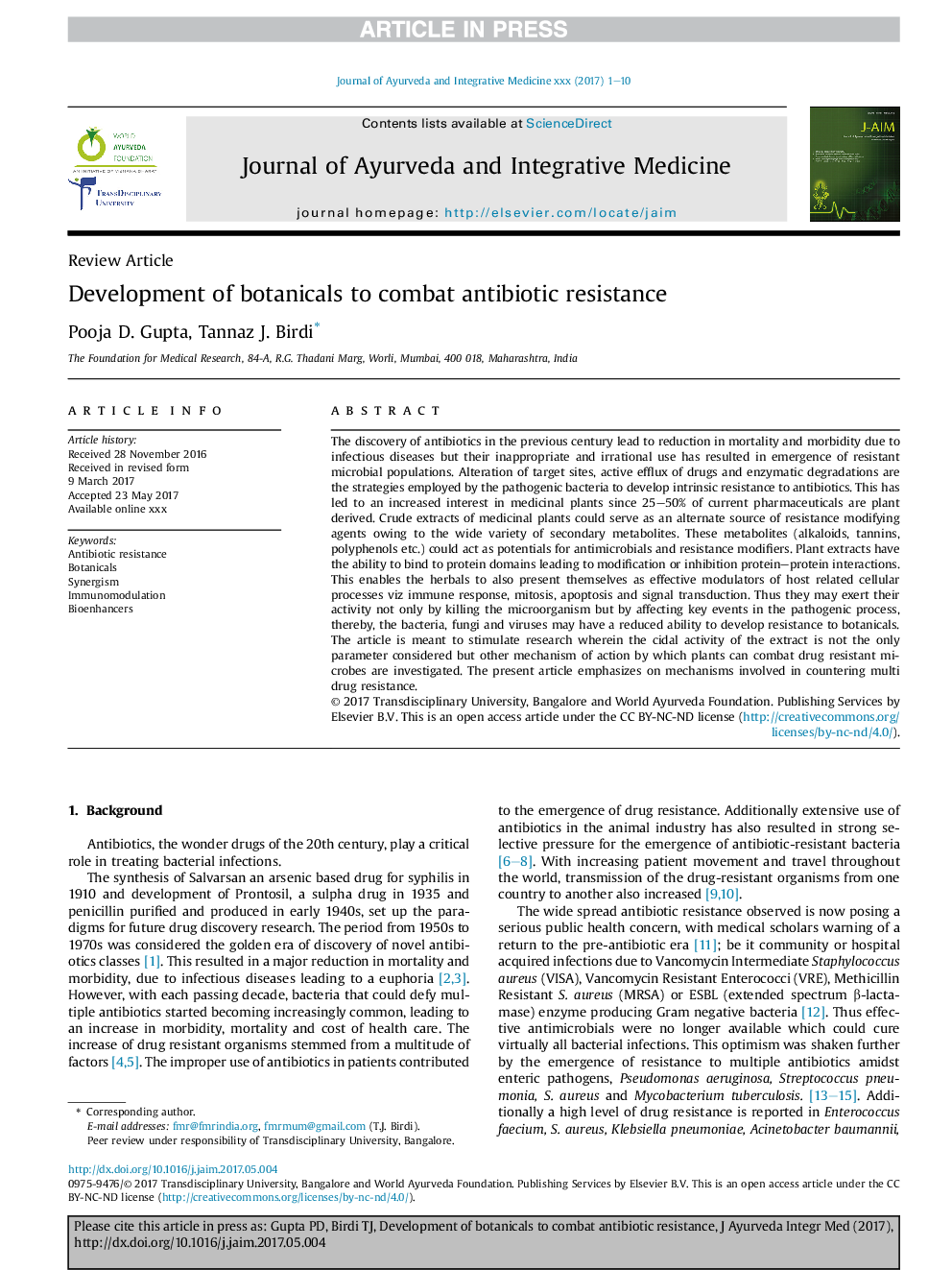| کد مقاله | کد نشریه | سال انتشار | مقاله انگلیسی | نسخه تمام متن |
|---|---|---|---|---|
| 8692966 | 1581564 | 2017 | 10 صفحه PDF | دانلود رایگان |
عنوان انگلیسی مقاله ISI
Development of botanicals to combat antibiotic resistance
ترجمه فارسی عنوان
توسعه گیاهان برای مبارزه با مقاومت آنتی بیوتیکی
دانلود مقاله + سفارش ترجمه
دانلود مقاله ISI انگلیسی
رایگان برای ایرانیان
کلمات کلیدی
ترجمه چکیده
کشف آنتی بیوتیک ها در قرن گذشته سبب کاهش مرگ و میر و عوارض ناشی از بیماری های عفونی شده است، اما استفاده نامطلوب و غیر منطقی آنها موجب ظهور جمعیت های مقاوم به میکروبی شده است. تغییرات سایت های هدف، خروجی فعال دارو و تجزیه آنزیمی استراتژی هایی است که توسط باکتری های بیماریزا برای توسعه مقاومت در برابر آنتی بیوتیک ها استفاده می شود. این به افزایش علاقه به گیاهان دارویی منجر شده است؛ از 25 تا 50 درصد داروهای کنونی گیاه مشتق شده است. عصاره های خالص گیاهان دارویی می تواند به عنوان منبع جایگزین عوامل اصلاح کننده مقاومت به دلیل طیف وسیعی از متابولیت های ثانویه ای مفید باشد. این متابولیت ها (آلکالوئیدها، تانن ها، پلی فنل ها و غیره) می توانند به عنوان پتانسیل های ضد میکروبی و اصلاح کننده های مقاومت عمل کنند. عصاره های گیاهی توانایی اتصال به پروتئین ها را دارند که منجر به تغییر یا مهار پروتئین و پروتئین می شود. این گیاهان را قادر می سازد تا خود را به عنوان مدولاسیون موثر پروسه های مرتبط با میزبان مرتبط با پاسخ ایمنی، میتوز، آپوپتوز و انتقال سیگنال معرفی نمایند. بنابراین آنها ممکن است فعالیت خود را نه تنها با کشتن میکرو ارگانیسم بلکه با تأثیر بر رویدادهای کلیدی در فرآیند بیماری، به این ترتیب، باکتری ها، قارچ ها و ویروس ها توانایی کاهش توانایی رشد مقاومت گیاهان را داشته باشند. مقاله به منظور تحریک پژوهش است که در آن فعالیت سییدال عصاره تنها پارامتر مورد نظر نیست، بلکه مکانیسم دیگری که توسط گیاهان می تواند با میکروب های مقاوم در برابر دارو مبارزه کند، مورد بررسی قرار می گیرد. مقاله حاضر بر مکانیزم های درگیر در مبارزه با مقاومت چند دارویی تاکید دارد.
موضوعات مرتبط
علوم پزشکی و سلامت
پزشکی و دندانپزشکی
طب مکمل و جایگزین
چکیده انگلیسی
The discovery of antibiotics in the previous century lead to reduction in mortality and morbidity due to infectious diseases but their inappropriate and irrational use has resulted in emergence of resistant microbial populations. Alteration of target sites, active efflux of drugs and enzymatic degradations are the strategies employed by the pathogenic bacteria to develop intrinsic resistance to antibiotics. This has led to an increased interest in medicinal plants since 25-50% of current pharmaceuticals are plant derived. Crude extracts of medicinal plants could serve as an alternate source of resistance modifying agents owing to the wide variety of secondary metabolites. These metabolites (alkaloids, tannins, polyphenols etc.) could act as potentials for antimicrobials and resistance modifiers. Plant extracts have the ability to bind to protein domains leading to modification or inhibition protein-protein interactions. This enables the herbals to also present themselves as effective modulators of host related cellular processes viz immune response, mitosis, apoptosis and signal transduction. Thus they may exert their activity not only by killing the microorganism but by affecting key events in the pathogenic process, thereby, the bacteria, fungi and viruses may have a reduced ability to develop resistance to botanicals. The article is meant to stimulate research wherein the cidal activity of the extract is not the only parameter considered but other mechanism of action by which plants can combat drug resistant microbes are investigated. The present article emphasizes on mechanisms involved in countering multi drug resistance.
ناشر
Database: Elsevier - ScienceDirect (ساینس دایرکت)
Journal: Journal of Ayurveda and Integrative Medicine - Volume 8, Issue 4, OctoberâDecember 2017, Pages 266-275
Journal: Journal of Ayurveda and Integrative Medicine - Volume 8, Issue 4, OctoberâDecember 2017, Pages 266-275
نویسندگان
Pooja D. Gupta, Tannaz J. Birdi,
